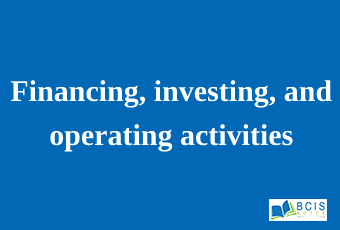
Financing, investing and operating activities
Operating activities include cash activities related to net income. Investing activities include cash activities related to noncurrent assets. Financing activities include cash activities related to noncurrent liabilities and owners’ equity.
The three categories of cash flows are operating activities, investing activities, and financing activities.
Financing activities
Financing activities include transactions involving debt, equity, and dividends. Cash flow from financing activities provides investors with insight into a company’s financial strength and how well a company’s capital structure is managed. Financing activities are transactions or business events that affect long-term liabilities and equity. In other words, financing activities are transactions with creditors or investors used to fund either company operations or expansions. These transactions are the third set of cash activities displayed on the statement of cash flows.
Example
Financing activities include both cash inflows and outflows from creditors and investors. Cash inflows from creditors usually consist of new loans issued to the company, while cash outflows from creditors include loan and interest payments. Issuances of bonds and bond payments have also consisted of financing activities.
Cash inflows from investors occur from newly issued stock or contributions from partners; whereas, cash outflows from investors consist of dividends and owner distributions.
Not all financing activities affect cash, however. Some projects are financed directly. Take a company building a new building for example. If the building is completely financed by a mortgage, the cash account is never changed. The liability account is increased and the building account is increased.
Investing activities
Investing activities are the second main category of net cash activities listed on the statement of cash flows and consist of buying and selling long-term assets and other investments. In other words, this is the net amount of cash received and paid during an accounting period for long-term assets and investments. You can think of these activities as the money a company uses to invest in itself or the money it makes from its investments.
Example
Here’s a shortlist of common cash inflows and outflows listing in the investing section of the cash flows statement.
Inflows
- Cash collected from:
- Selling trading, held for sale, and available for sale securities
- Selling discounted notes
- Selling long-term productive assets
- Collecting principle on the third party notes that don’t generate sales
Outflows
- Cash paid to:
- Purchase trading, held for sale, and available for sale securities
- Purchase long-term productive assets
- Pay principle on the third party notes that don’t generate sales
Operating activities
Operating activities consist of principle activities that a company performs to earn income. In other words, these are the primary business operations that a company performs to earn revenue. This is what the company is in business to do. These cash inflows and outflows from operating activities are reported on two different financial statements. First, they show up on the income statement and are used to compute net income. Second, they are reported on the statement of cash flows. This statement shows how cash from three main sources (operating activities, investing activities, and financing activities) increased or decreased during the period. Let’s look at an example.
Example
Take Best Buy for instance. Best Buy purchases electronics and appliances from manufacturers and sells them to customers. So any activity that is involved in Best Buy purchasing inventory or selling inventory to customers is considered an operating activity. This can even include administrative expenses. As long as the activity is related to selling goods to customers, it is considered an operating activity.
Best Buy also has activities that are not directly related to selling products to customers like selling fixed assets, getting loans from banks, or paying dividends to shareholders. None of these activities are considered operating activities because they can’t be related back to Best Buy’s principal business activity: selling products to customers. These activities would either be considered investing or financing activities. Sometimes these three categories can get confusing.
Just remember that principle activities include any cash inflows or outflows that relate to the primary business activity or the activity that the business performs to earn a profit. Every other activity is not considered an operating activity.
You may also like the Purpose of the statement of cash flows

Leave a Reply